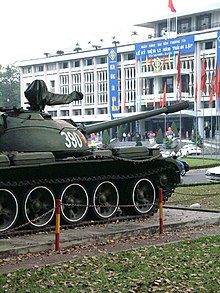Spring offensive in Vietnam 1975
The 1975 Spring Offensive marked the final leg of the Vietnam War . This military operation was a series of large-scale and ambitious offensive operations by North Vietnam and the Viet Cong that began on December 13, 1974. The aim of these operations was to defeat the army of South Vietnam once and for all and to get the government of South Vietnam to surrender. After the initial success of an initially limited campaign in the province of Bình Phước , the North Vietnamese leadership increased the scope of the offensive of their people's army and quickly threatened the town of Buôn Ma Thuột in the mountains.

The new offensive differed from the indecisive Easter Offensive of 1972. In 1973 the Treaty of Paris ("Agreement on Ending War and Restoring Peace in Vietnam") was signed. The reduction in American military aid, which had become the lifeblood of the South Vietnamese armed forces, caused material and psychological turmoil and decline in that army. US policy has been preoccupied with the aftermath of President Richard Nixon's resignation in the wake of the Watergate affair . The inability to find alternative military concepts hastened the collapse of South Vietnam. The fact that the United States had withdrawn from the Southeast Asian theater of war after many years had a devastating effect on the psyche of the political and military leadership of South Vietnam and on the civilian population.
Attempts to reduce the area of defensive areas in the northern provinces and to create a strategic national reserve have failed; the massive migration of refugees and the disorganization of the defense forces resulted in the loss of the northern two thirds of the country. Surprised by the speed of the South Vietnamese collapse, the aim of the campaign was expanded to include the conquest of the South Vietnamese capital Saigon in time for the celebration of President H Chí Minh's 85th birthday . This should also end the war. This part of the spring offensive is called the Ho Chi Minh Campaign. It made it necessary to move most of the attacker's northern forces more than 550 km south.
In the area around the capital Saigon, the South Vietnamese forces regrouped and created a considerable line of defense at the most important traffic junctions at Xuân Lộc and Phan Rang. At the same time, however, the political and military will to continue the struggle sank. Under political pressure, South Vietnamese President Nguyễn Văn Thiệu resigned on April 21, in the hope that a new leader who would be more accessible to North Vietnam could resume negotiations. But it was too late. A spearhead of the Vietnamese People's Army had already reached Saigon; the South Vietnamese government, now under the leadership of Dương Văn Minh , capitulated on April 30, 1975.